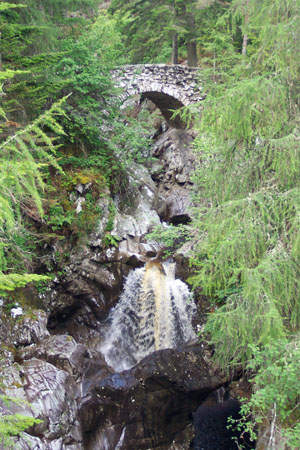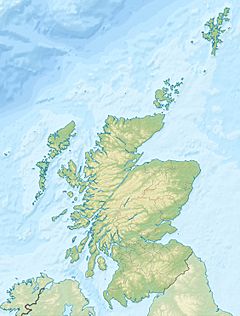Falls of Bruar facts for kids
Quick facts for kids Falls of Bruar |
|
|---|---|

The Lower Bridge over the falls
|
|
| Lua error in Module:Infobox_mapframe at line 185: attempt to index field 'wikibase' (a nil value). | |
| Location | Pitlochry, Perth and Kinross, Scotland |
| Coordinates | 56°46′43″N 3°55′58″W / 56.778671°N 3.932712°W |
| Total height | 60 m |
The Falls of Bruar are a beautiful series of waterfalls in Scotland. They are located near Pitlochry in the area called Perth and Kinross. The falls are about 8 kilometers (5 miles) from Pitlochry. People have been visiting these falls for fun since the 1700s. A famous Scottish poet, Robert Burns, even wrote a poem about them. He asked the Duke of Atholl to plant more trees around the falls.
Contents
Discovering the Falls of Bruar
The Falls of Bruar likely formed about 10,000 years ago. This was after the huge sheets of ice, called glaciers, melted away. The water slowly cut its way through the rocks. These rocks were pushed up by powerful forces that created the Scottish Highlands. This happened about 500 million years ago.
How the Falls Were Formed
The rocks here are in layers, some hard and some soft. The water has carved a winding path through the softer rock. It left the harder rock untouched. This created deep pools and rocky outcrops. In one spot, there is even a natural arch made of rock. The falls have two large drops and many smaller ones. The water often looks brown. This is because it flows through peat, which is a type of soil made of decayed plants.
Visiting the Falls Today
Today, the A9 road from Perth to Inverness passes close to the falls. There is a shopping center and a car park nearby. Visitors can easily access the falls from here. A circular walking path leads up to the Lower Bridge. This bridge is close to the natural arch. The path then continues to the Upper Bridge. This is about 500 meters (half a mile) from the car park. Finally, the path returns down the other side of the river.
The Height and Water Flow
The Falls of Bruar drop about 60 meters (200 feet) in total. The gorge is quite narrow. This means the falls look most impressive after heavy rain. However, a hydroelectric power scheme was built in the late 1940s. This scheme takes some water from the river further upstream. Because of this, the falls do not have as much water as they once did.
The History of Bruar Falls
The Falls of Bruar first became a popular place for tourists in the late 1700s. At that time, the area around Bruar Water had no trees. It was a bare and empty landscape. Visitors often found the falls a bit disappointing. They had to walk over slippery rocks and steep banks to see them.
Early Visitors' Views
William Gilpin visited the falls in 1776. He thought they were "Scarce worth so long and perpendicular a walk." He felt that even the grandest fall was "of little value" because there were no trees around it.
Robert Burns's Famous Poem
Robert Burns visited the falls in 1787. He liked the waterfalls themselves. But he was not happy about the lack of plants and trees. After his visit, he wrote a poem called The Humble Petition of Bruar Water to the Noble Duke of Atholl. In the poem, the river itself asks John Murray, 4th Duke of Atholl, who owned the land, to plant trees and bushes:
Would then my noble master please
To grant my highest wishes,
He'll shade my banks wi' tow'ring trees,
And bonnie spreading bushes.
"Planter John" and His Vision
Almost ten years later, after Burns passed away in 1796, the Duke of Atholl began a huge planting project. He eventually planted 120,000 Larch and Scots Pine trees. The Duke believed that planting trees should be both beautiful and profitable. He became known as "Planter John." He planted over 15 million trees across his lands during his lifetime.
At the Falls of Bruar, the Duke also created the walking path that people still use today. He built the two bridges to offer great views of the falls. He also built many small huts and shelters. Some visitors did not like these huts, and they eventually fell apart. Only parts of one stone hut can still be seen.
Changes Over Time
William Wordsworth visited in 1815. He did not like how neat the paths were. However, the paths have become softer and more natural over the years. During the Victorian period, many Rhododendron plants were added to make the landscape even prettier.
Most of the trees were cut down during World War II. After the war ended, new trees were planted. These included Scots Pine mixed with Hybrid Larch, Fir, and Spruce. Native trees were also allowed to grow naturally. Today, you can see conifers mixed with Mountain Ash, Willow, Aspen, and Birch trees.
Images for kids



